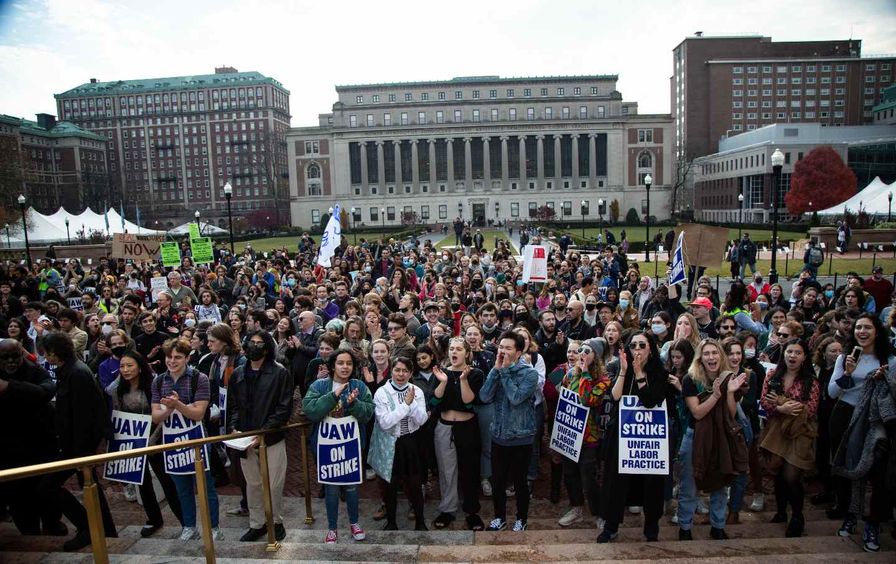By John Santoro
Nomadic employees. Expanding ranks of “permanent temps.” Different tiers of pay for the same work.
Standard operating procedures for Big Three? Yes—and also for Big Academics, including many of the nation’s largest universities.
This year’s UAW Special Bargaining Convention can unite the largest group in the UAW—auto industry workers—and its fastest-growing group—academic workers in higher education. Both are suffering from entrenched and growing employment practices that erode job security, benefits and pay, while pitting one class of workers against another.
Newly elected, UAWD-backed officials, led by incoming UAW President Shawn Fain, have pledged to confront the injustice of tiered pay and abuse of temporary workers, whether this takes place on the assembly lines of automakers or in the classrooms of prestigious universities.
The “Permanent Underclass” of Adjunct Professors
Consider the ties that bind newly hired autoworkers with newly hired academic workers. Both must endure compensation practices and job security situations that often place them one missed paycheck away from serious financial trouble.
For academic workers, America’s universities have largely replaced full-time professors with adjunct instructors, who are paid by the course, in roles often lacking meaningful benefits and job security. This has led to an explosion in adjunct professors who aspire to become full-time teachers—“perennial adjuncts”—stringing together a series of courses to eke out a living.
Journalist Adam Harris, writing in The Atlantic, puts it plainly. “To be a perennial adjunct professor is to hear the constant tone of higher education’s death knell. The story is well known—the long hours, the heavy workload, the insufficient pay—as academia relies on adjunct professors, non-tenured faculty members, who are often paid pennies on the dollar to do the same work required of their tenured colleagues.”
Economics heavily favor the university. Pass by a typical college class—say, 15 to 25 students—at a major university and you are looking at $200,000 or more as tuition and other income to the school. Yet the adjunct professor in front of the class is generally earning just 2% to 6% of this income for each class taught.
Tales of New York
Zoe Carey, who serves as president of UAW 7902, represents more than 4000 adjuncts at two of the nation’s most expensive universities: NYU and The New School. Both are located in Manhattan. Both charge undergraduates in excess of $75,000 a year for tuition, fees and room and board. And, at both adjuncts teach a majority of the classes.
During negotiations with NYU in 2022, Carey and the NYU Bargaining Committee invited adjuncts to tell their stories directly to the NYU negotiators.
“The other side heard testimony after testimony of highly trained, highly dedicated teachers who had to rely on government programs for healthcare and even for food security. They heard stories about adjuncts rationing food and only being able to afford one meal a week, while spending a dozen uncompensated hours weekly preparing for classes, advising students, and grading. They adjuncts on the verge of exhaustion and stories about instructors told at the last minute that they didn’t have a course to teach after years of being effective, even inspirational teachers. And this was from NYU, where the pay and benefits we had under our old contract was far higher than most American adjuncts make right now.”
The UAW has a substantial history of organizing academic workers, including graduate assistants and adjunct professors. Member-led, disciplined organization has often earned academic workers substantial gains, be they for graduate student workers in the University of California System to the adjuncts at both The New School and NYU. Behind an overwhelming mandate by Local 7902 to strike, NYU finally offered proposals that included a 34% raise for the lowest-paid adjuncts and features such as pay for administrative duties once considered “university service.” This new contract narrows the pay gap between adjunct professors teaching a course load to full-time entry-level faculty, who generally work on a year-to-year contract. The New School UAW unit was forced to go on strike for three weeks but succeeded holding onto rights and benefits the university tried to erode, while winning significant raises for the lowest-paid faculty.
A Critical Alliance in Taking Back Concessions
All in all, while they do different kinds of work, the goals of UAW autoworkers and academic workers intersect in the fight for fair pay, needed benefits, job security and working conditions that dignify everyone’s labor. What happens this year in negotiations with the Big Three and Caterpillar will set the tone for progress for years to come—and reverberate not only in the ways America makes autos, but also in the ways U.S. universities prepare generations to come. It’s time to make “solidarity” an imperative—not just a catchword—for all sectors in the UAW.

